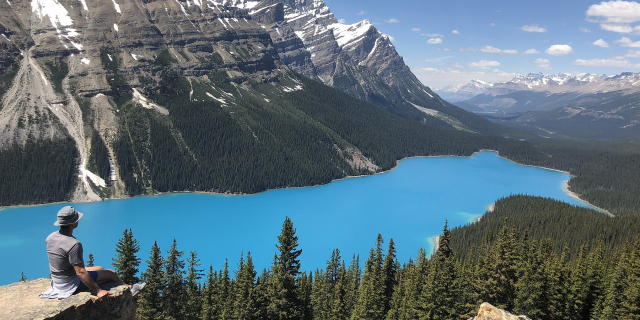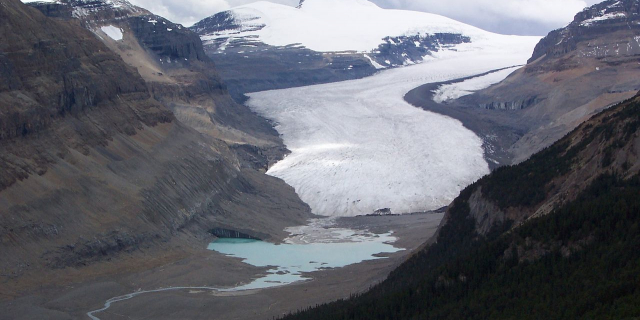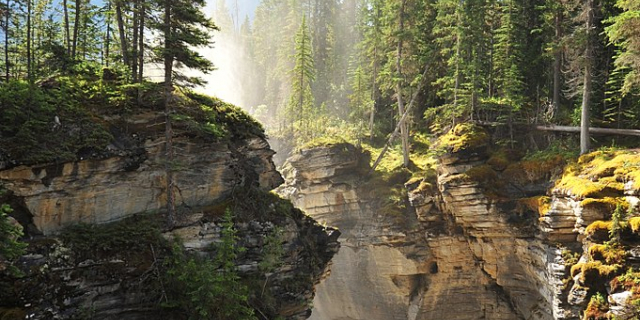Kootenay National Park is a national park of Canada in southeastern British Columbia. The park consists of 1,406 km2 (543 sq mi) of the Canadian Rockies, including parts of the Kootenay and Park mountain ranges, the Kootenay River and the entirety of the Vermilion River. While the Vermilion River is completely contained within the park, the Kootenay River has its headwaters just outside the park boundary, flowing through the park into the Rocky Mountain Trench and eventually joining the Columbia River. The park ranges in elevation from 918 m (3,012 ft) at the southwestern park entrance to 3,424 m (11,234 ft) at Deltaform Mountain.
Initially called "Kootenay Dominion Park", the park was created in 1920 as part of an agreement between the province of British Columbia and the Canadian federal government to build a highway in exchange for title to a strip of land, approximately 8 km (5.0 mi) on either side of the 94 km route, the Ba...Read more
Kootenay National Park is a national park of Canada in southeastern British Columbia. The park consists of 1,406 km2 (543 sq mi) of the Canadian Rockies, including parts of the Kootenay and Park mountain ranges, the Kootenay River and the entirety of the Vermilion River. While the Vermilion River is completely contained within the park, the Kootenay River has its headwaters just outside the park boundary, flowing through the park into the Rocky Mountain Trench and eventually joining the Columbia River. The park ranges in elevation from 918 m (3,012 ft) at the southwestern park entrance to 3,424 m (11,234 ft) at Deltaform Mountain.
Initially called "Kootenay Dominion Park", the park was created in 1920 as part of an agreement between the province of British Columbia and the Canadian federal government to build a highway in exchange for title to a strip of land, approximately 8 km (5.0 mi) on either side of the 94 km route, the Banff–Windermere Highway, to be used solely for park purposes. While the park is open all year, the major tourist season lasts from June to September. Most campgrounds are open from early May to late September, while limited winter camping is available only at the Dolly Varden campground.
Kootenay National Park is one of seven contiguous national and provincial parks that form the Canadian Rocky Mountain Parks World Heritage Site. The Continental Divide is the boundary between Kootenay and Banff National Park, as well as the British Columbia–Alberta provincial border. To the northwest, the watershed boundary between the Vermilion River and the Kicking Horse River serves as the boundary between Kootenay and Yoho National Park. Mount Assiniboine Provincial Park also borders Kootenay; Jasper National Park, Mount Robson Provincial Park and Hamber Provincial Park make up the remainder of the World Heritage Site but do not share a boundary with Kootenay National Park.
Archaeological evidence suggests humans have been either traveling through, or temporarily residing in, the area for about 10,000 years.[1][2] Pictographs found in the hot spring caves indicate that Ktunaxa people first made more permanent use of the area, particularly the hot springs, several hundred years ago.
European fur traders and trappers passed through, as did George Simpson in 1841, through what would later be named Simpson Pass, during his circumnavigation of the world. Likewise, James Sinclair led Red River colonists westward and Pierre-Jean De Smet travelled eastward, through the area. The Palliser expedition used the Vermilion Pass in 1858 and reported to British government its potential as a transportation route. On the Columbia River side, an early homesteader included the hot spring that would later become Radium Hot Springs in his land claim in the 1880s, but it was Roland Stuart and his business partner H.A. Pearse who were successful in acquiring the 160 acres (0.65 km2) around the springs in 1890 as a provincial Crown grant. While they intended on bottling the spring water, its remote location prevented such development and Stuart offered to sell the property in 1909 to the Canadian Pacific Railway Company for $3000. Though the offer was not accepted, railway engineer Robert Randolph Bruce recognized the potential for a road through the area and advocated for it in 1910 with CPR president Thomas Shaughnessy and Premier Richard McBride, as a commercial link for the province to Calgary and eastern Canada. The federal government agreed to build a road from Banff to the park boundary at the provincial border at the Vermilion Pass, while the provincial government, with some funds from the CPR, would build a road from Windermere to the border. However, the BC government under-estimated its cost, found itself over-budget and its work was suspended in 1913, while the federal government completed their portion in November 1914. To get the British Columbia section completed, Bruce travelled to Ottawa to pitch the idea that they designate the western end of the route, through the Rocky Mountains, a national park so that road could be funded as a park improvement. With the popularity of Rocky Mountains Park, the Commissioner of the Parks Branch, James Bernard Harkin, and officials of the Ministry of the Interior were receptive to expanding the park system there.
In May 1916 the Minister of the Interior, William James Roche, began negotiations, and the subsequent minister agreed with the provincial counterparts to the Banff-Windermere Agreement, that the federal government would complete the road within 4 years of the end of the Great War, and maintain it thereafter, in exchange for the agreed-upon land to be used for park purposes and a resolution to jurisdictional matters in the other federal parks in BC. The agreement was signed on March 12, 1919, and the federal government took ownership of the land in July. By Order in Council 1920-0827 on April 21, 1920, the Kootenay National Park was created. The federal government repaired the provincial portion of the road and completed the remainder for public opening by June 1923.[3]





























Add new comment